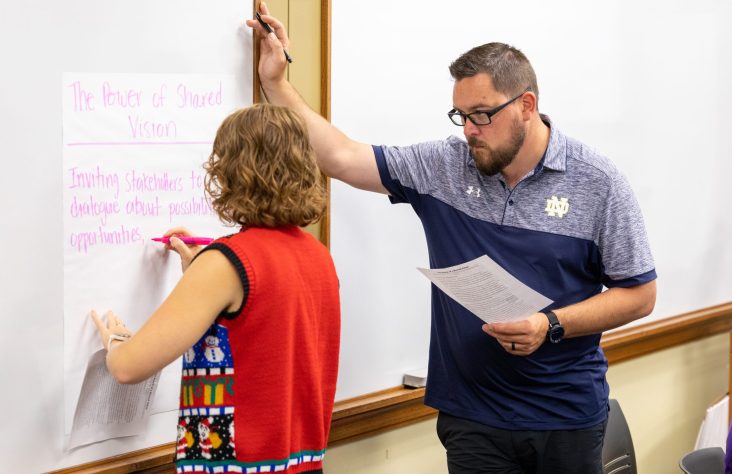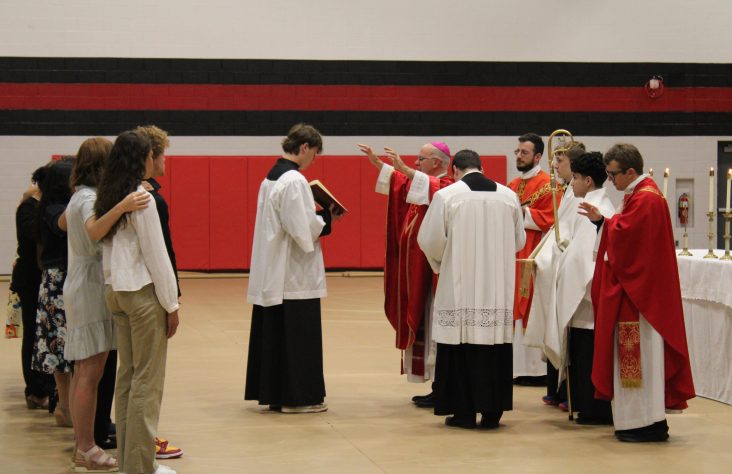September 25, 2018 // Diocese
The annulment process in practice: Mary’s story
Soul-searching.
Uncomfortable.
Difficult.
The words used to describe the annulment process, by people who have gone through it, are gloomy. How could they not be? The process of determining the validity or invalidity of a marriage inherently requires a sobering amount of reflection about an already-painful subject — an intimate relationship that has been, in some form, betrayed — as well as a profusion of humbling realizations regarding one’s role in the failure, and the embarrassment of having to discuss those realizations with friends and family.
Mary was one of 15 children in a family that attended Mass regularly and sent their children to Catholic schools. Her mother and father were “these devout Catholics of the days of old — but they never talked about their faith at home,” she recalled. She attributes the several divorces that took place among herself and her siblings to that fact. “I think it’s because that example, it was just never there. And truthfully, then, you start to look for love in all the wrong places, like that old song.”
In 1974, against her mother’s wishes, Mary married a man with whom she had little in common. “I knew better,” she now admits. The couple had one son.
As their relationship deteriorated, she realized that she really hadn’t taken any time to discern their marriage before it took place. In 1981, they divorced.
First attempt
About nine months after the divorce, Mary began the annulment process. “In order to ever marry again, I had to do that, and I knew it. I hoped to someday meet a man who was on the same page I was about God and life.”
She went to the priest at her Fort Wayne parish, who gave her paperwork to fill out.
“It was extensive. It made me dig into me. I had to go back and search myself: What were my interests when I was young? What was my family background? What happened in my first marriage? I mean, it was intense. It took me probably six months to finish, because I had to do a lot of soul-searching … but it was part of the healing process. Putting it on paper made it more real, what I had done — to my own self, basically.”
“That was back in the time when you had to write out the answers to all those questions … It took me months. I used it as a tool to just lay it all down. The questions are pretty pointed, and I didn’t treat them lightly. I remember putting my head down on the paperwork a couple of times and just crying my head off, because I got myself into that big, fat mess.”
Mary eventually turned in the paperwork, but more challenges were on the horizon. The head of the diocesan tribunal at the time, Father Michael Rosswurm, was initiating a program to train lay advocates who would help guide petitioners through process: He asked if he could conduct Mary’s annulment interview — normally a private part of the process — in front of the entire group, to aid in their understanding.
“I remember being scared to death,” she said. But seeing it as an opportunity to follow God’s will for her life, she said, “Yes,” and relived the details of her personal life in front of a small audience.
The picture Mary had in her head of the annulment process was that of an old-fashioned apothecary, or library file-card cabinet, inside the tribunal. The cabinet had thousands of rows of drawers, each one just big enough to hold a few papers. “As I imagined it, my paperwork was going up and down the rows, up and down, for a year. And then, because I couldn’t get anybody to participate as a witness, they stopped.”
Mary’s friends didn’t understand the annulment process, didn’t want to get involved, or didn’t think it was right; some of them held misconceptions about what happens to the children of an annulled marriage.
“The tribunal office called and said, ‘It’s kind of at a standstill.’ So that’s where it sat for about three years.”
Second attempt
Despite Mary’s civil divorce from her husband, her marriage was still sacramentally valid. She had not entered into another union, so she was free to continue to receive Christ in the sacrament of holy Communion — until, in 1983, Mary exchanged vows with Jeff Schafer, someone she had met at work. “I knew it was wrong,” she said. “When you fall in love, you do stupid things.”
The family continued to attend Mass every weekend, becoming involved in service to St. Vincent de Paul School, where her son received his early education. Mary desired to have their marriage blessed in the Catholic Church, though, so that she could return to the Eucharist.
She had resigned herself to the idea that her stalled petition meant there might never be annulment. But after a few years, a family friend suggested Mary ask to have her case reactivated. She did, and as she revisited parts of the process, she learned that the two friends whom she had originally asked to be witnesses, but who had refused, were now of a different mind.
Since the time Mary first approached them, they had participated in the annulment process of family members. “‘Now we understand why you needed us,’” they told her.
About a year later, Mary’s case was granted a decision by the tribunal. After evaluating all the evidence and the facts in the case, the judge was able to decree that there had been a problem in Mary’s first marriage, which meant that it was actually invalid from the beginning. Similarly, Jeff’s first marriage was investigated and found to be invalid as well. Therefore, both Mary and Jeff were found to be free to marry. On Dec. 8, 1990, Jeff and Mary Schafer were married at St. Vincent de Paul Church.
Memories of the emotional and procedural difficulties of the annulment process remain with her. They have also given her insight that she has constructively applied in her second marriage. “Jeff and I, we’ve had many very honest conversations with each other about how it was a lot up to us what happened in those first marriages — and how we should have given them better attention and grooming, and sought spiritual advisement. Because neither one of us did that.”
She considers her experience to have been appropriate and necessary. “I had to do that. God had a plan for me. Life isn’t easy, and when you travel into the sinful things — and they are sinful — when you think you know better than anything, you have to pay the price,” she said. ‘You can’t come out the other side if you don’t. You just can’t.”
The best news. Delivered to your inbox.
Subscribe to our mailing list today.






